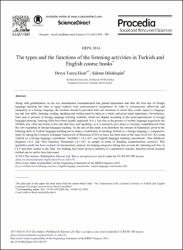The types and the functions of the listening activities in Turkish and English course books
Abstract
Along with globalization, in our era, international communication has gained importance and thus the first aim of foreign language teaching has been to equip students with communicative competence. In order to communicate effectively and adequately in a foreign language, the students should be provided with real situations in which they would expose to language use and four skills, listening, reading, speaking and writing must be taken as a whole and given equal importance. Nevertheless, from past to present, in foreign language teaching methods, which are shaped according to the aims/requirements of foreign language learning, listening skills have been usually neglected. It is a fact that in the process of mother language acquisition the children stay silent and listen at first and then they start speaking, so it is natural to give place to listening comprehension from the very beginning in foreign language teaching. As the aim of this study is to determine the amount of importance given to the listening skills in Turkish language teaching and to make a contribution to teaching Turkish as a foreign language, a comparative study by taking the Common European Framework of Reference (CEF) as basis has been done at the basic level (A1-A2) using Turkish as a foreign language coursebook 'YeniHitit 1 (A1-A2)' and English language teaching coursebooks New Headway Beginner (A1)' and New Headway Elementary (A1-A2)' as sample in terms of listening comprehension exercises. This qualitative study has been realized via documentary analysis developing categories taking into account the listening activities in CEF and other studies in the field. The findings have been given in numbers in a quantitative manner, therefore mixed research method can be said to have been used. (C) 2014 The Authors. Published by Elsevier Ltd.



















